
Breeding a litter maybe fun, never simple
By Lies Klösters, 2004
You have a dream; a beautiful queen who will give you beautiful, healthy kittens to cuddle, to play with, to take care of... How to realize this dream?
Maybe the following 'book' can help you to make this dream come true.
- Introduction
- Ethics
- Breeding animals
- Housing
- Stud service
- Pedigree knowledge
- Genetic defects
- Equipment
- General Care
- Dangers
- Determining Gender In Kittens
- Socialization
- Administration
- Recommended literature
Introduction
Breeding animals - if you are serious about it - entails more than one at first assumes. Beginners don't see the forest for the trees, and almost everybody makes the same mistakes. In this article we mention some aspects of breeding and give a few tips for starting breeders. But this article is absolutely not enough. After you have read this you are still a beginner and you still have a lot to learn. Hopefully you did learn a few things, and have started to think about some issues that are involved in breeding.
Ethics
Why do you want to breed? Do you want to just, once, have a litter, or do you want to get seriously involved with your breed? If you just want a litter, you don't need purebred cats. You can also take two household pets that have kittens together. Aren't all kittens neat and endearing, whether they have a pedigree or not?
If you earnestly want to get involved with a breed, then maybe you have also already thought about a breeding programme. Breeding is more then simply getting a nice tomcat for your female breeding cat (queen). You should try to plan a few generations ahead. Breeding plans are always subjected to changes since cats have a mind of their own. These are some examples that can mess up your plans:
- The queen does not get in heat.
- The stud sprays so much that his owner had him neutered before your cat was bred.
- The queen does not get impregnated and even after a couple of times being bred, is not pregnant.
- The queen does not want to breed with the stud that you chose for her.
But if you have a breeding goal in mind, then you can keep working towards it.
Having settled on a breeding goal does not mean that you may never change it. You should see it rather as a guideline, to help you with your decisions. After a while you may conclude that your breeding goal needs adjustment. For instance because there are developments in your breed that make your breeding goal unattainable, or because, with all your new knowledge, you decide that your prior breeding goal was not all that worthwhile.
Having a breeding goal ensures that you will not start breeding in a way that is better described as 'multiplying', and become a so-called backyard breeder. Many beginning breeders say "I think it would be fun, to just breed a litter ...". Experienced breeders often object to this. Any self-respecting breeder tries to improve the breed, not just produce kittens. Only, what is improvement of the breed? Is that a healthier cat? Or a more beautiful cat or a more likable cat? Most breeders try to produce a healthy, beautiful and likable cat .... Most people will agree on what is a likable cat, but what is healthy and beautiful? There are many different opinions about that. What makes a cat beautiful is a matter of taste. You can follow your own taste, as long as it falls within the breed standard. A healthy cat is a cat that for example reaches an age of 10 years without all kinds of diseases.
Also, think of the influence that your breeding decisions may have on the gene pool. If, for example, you breed a litter of 8 kittens, and you sell all 8 to other breeders, is that good for your breed? And if you get two more litters from the same queen and you sell all those kittens also to breeders, what is then the effect? On the other hand, if you breed a litter with a unique combination of parents, and you sell not a single kitten to breeders, what is in that case your contribution (positive or negative) to the breed? Or would that be backyard breeding? (Please do not read this as if you have to sell a kitten from each litter to breeders. It is purely meant to make you think hard about your reasons to breed a litter.)
Breeding animals
The breeding animals that you select constitute the basis of your breeding program. So you will want to have good breeding animals. But where do you find them? And what are good breeding animals?
Looking for a good breeding animal starts with looking for a good breeder. But this raises the same questions as above: where do you find a good breeder and what distinguishes a good breeder?
There are no fixed answers to these questions. What one would consider a good breeder, may be deemed a bad breeder by somebody else. But what you should experience with a breeder, is a good feeling! Take the time to get to know the breeder. Visit a couple of times (gives you the chance to see the kittens a couple of times, that is always fun!) and talk with him (her). What are his thoughts about tests, about breeding and all that is involved, how are the cats housed. What is his feeling that you want to breed with his kitten? (Please note: not all breeders allow just anybody to breed with their kittens. Talk this over before you buy the kitten.) If you feel comfortable with each other, then you have made a good start. You don't have to become soulmates, but if your ideas by-and-large agree, then things are falling in place. Do ask for the contract for the kitten, so that you can study it at home. At a next visit you can ask for clarification, and discuss the contract.
Also you can ask other breeders for their opinion on the breeder that you visited. Ask several breeders; one may have a disagreement with the breeder of your kitten, and may therefore give a bad reference. Ask 3 or 4 persons for their opinion. If they all say the same, then you know that the stories are probably true. By the way, a good breeder will also try to get references! Do not be insulted if it turns out that questions were asked about you. The breeder only wants to check whether you told the truth. Also, the breeder can interrogate you when you are visiting. What is your opinion about breeding, what do you know about breeding, about -for instance- genetics, diseases, raising kittens, etc. Some breeders make you feel like you are being challenged by the Spanish Inquisition. But just like you want to know whether you are buying a kitten from a dedicated and sincere breeder, such a good breeder will want to know if he sells the kitten to someone who will be conscientiously and sensibly involved in breeding.
The final choice
OK, you found a good breeder and you want to buy a kitten from him (her). Then the question arises: which kitten do you want? Study the cats that that breeder has. Decide from which cat (or combination) you want a kitten. This does not mean that that is the kitten you will get ... the breeder has his own breeding goals, and together you will have to determine whether your plans harmonize with one another. If this is not the case, then still you may be the better for it: maybe the breeder has better plans than you had. Another possibility is that the breeder likes the plans that you present. But in any case it shows that you thought about what you want.
The selection of which animal you choose can be based on varying criteria. It differs per person, but also depends on the breed that you chose. If you want to breed Maine Coons or Norwegian Forest cats, then it is possible that aside from other considerations, you would also like to have a kitten of a special colour. But if you want to breed Russian Blues, then colour will not be a selection criterion.
A criterion that applies to everybody is: what animals have most breeders in my neighborhood. You will have to cooperate with other breeders regularly to get ahead towards your breeding goal. You will have to buy cats from other breeders, or mate your cat with somebody else's stud. If you buy a kitten that is related to the cats of the breeders in your neighborhood, then you will not easily find a suitable partner for this cat.
Finally: don't take hasty decisions. If everything works out, this kitten will be the founding cat of your breeding programme. That is why you look for the very best kitten that you may get. Reason enough to -if need be- wait half a year or a year for the right kitten, isn't it? You can use that time to further study your breed, and everything that is related to breeding!
Housing
Most people that decide to start breeding cats, do so because they already have had cats for a while and they are so charmed by these animals that they want to breed them. From this point of view, you would think that breeders house their cats as a part of the household, since their hobby started this way. However, this is not always possible. For instance when you have an open tomcat - it is not always possible to let him have the run of the house. The chance for unplanned matings and unwanted behavior like spraying is just too great. So most breeders will keep their tomcat(s) in a stud accommodation. Most associations have rules for the minimal requirements of such accommodations, such as the size, windows, company, etc. Ask your association for their rules. As example a couple of such rules in a Dutch association:
- The accommodation has to have a minimal floor space of 6m2, and be minimally 2 meters high.
- The accommodations must admit daylight, and preferably allow the cat to look outside and sit in the sun.
- There should be fresh water and food, and attributes to combat boredom, such as toys and a scratching post.
- The cat may not be denied company (human or animal) too long.
- The accommodations need to be disinfected at least once a week.
This is only a selection out of the rules, and these are only MINIMAL requirements. Other animals besides open stud cats hardly ever need separate accommodations, they can be part of the household and participate in the daily routine without causing problems.
Giving or getting stud service.
Stud service has two sides:
- if you have a stud, you can give other breeders stud service, or
- if you don't have a stud, you can get stud service from another breeder.
Getting stud service is not easy. Many breeders do not want their tom to get too many kittens, and are choosy in giving stud service. Also stud owners like the visiting queens to be tested for many things. Not every owner of a female cat wants to co-operate in this respect. Moreover, many stud owners would at some point like to get a stud service, so they make arrangements with other stud owners. If you don't have a suitable stud yourself, such an exchange is not possible. Stud owners may get a lot of requests for their cat, and they can be very selective about the visiting queen cats. Outsiders often experience this as being a closed clique, and this is indeed often the case. That is because a lot of trust is involved: the owner of the female cat wants to leave her in an environment where she will be well cared for, and from where she will not return with nasty infections, and the stud owner does not want his cat to get infected with something strange, and he wants the kittens to be responsibly handled. And also it often is a case of "one hand washes the other" ...
If you do find a stud owner who right away agrees to have his cat mate with your cat, do not jump for joy immediately either. It may sound strange, because you finally found the person who will help you to get your first litter. But if he so readily agrees to you, he probably grants a mating to everybody. Then ask yourself how interesting your kittens will be for the diversity of the gene pool? Interesting outcross kittens on which you can build further towards your breeding goal, or thirteen-to-a-dozen kittens like you see in every other household? Moreover, if the stud owner does not expect your cat to be tested for diseases and defects, then did he test his cat? Are you sure you want kittens from that tom? Breeding cats (both male and female!) should be minimally tested for leukemia (FeLV) and aids (FIV), and of course the animals should be current on their vaccinations.
Buying a male cat is not always easy either. Many breeders rather not sell their male kittens to other breeders. There are various reasons for this:
- A stud can have a great influence on the population (a tomcat can have a lot more offspring in a year than a queen cat). As a breeder you just have to wait and see whether the new owner of the tomcat handles this responsibility correctly.
- Aside from that, housing an open tomcat is not easy, and not everybody follows the rules the different associations have about housing. As a result toms are sometimes kept at the most unsuitable places: in the basement, the attic, in the back of the yard in a small shed .... this also is something that many a breeder does not want to happen to his treasure.
If you do get a breeder to sell you a tomcat, please think hard about what you are doing, and take the next questions in consideration:
- Is this tom a good combination with your queens?
- What restrictions are attached to this kitten? Hardly any breeder sells a male kitten for breeding without restrictions. Examples of common restrictions:
a) A maximal number of stud services, or no stud service at all.
b) A maximal age to remain open (after which he must be castrated and must be part of the family without being restricted to the stud accommodations)
c) No kittens may be sold to other breeders, or only female kittens and no male kittens
All kinds of constructions are possible. Be very critical about which restrictions you are willing to accept, and which not. - Does it make sense to buy a tom if you are not allowed to give stud service and you yourself have only 1 or 2 females?
- Even if the tom is very beautiful and a good outcross for your queens and other female cats in the neighborhood, what influence will he have on the gene pool with only your two females as mates?
- Most breeders do not want to endlessly repeat the same mating (that is more like pure multiplying than making carefully designed combinations!) and so after 2 matings your stud may be 'finished'. Would it not be better to look for two stud services, instead of buying a tom? Moreover, in the situation described above it is much cheaper to pay for 2 stud services than to buy a tomcat (the total costs for your own stud are among others: the price, if you import a kitten the costs of transportation and maybe import taxes, taking care of the animal for at least a year, health checks and tests ...). Plus that some studs just are not happy with so few matings.
Pedigree knowledge
Knowledge of pedigrees is often underrated. For most beginning breeders it takes a while before they realize how important this is, and they learn later on what they have to look for in a pedigree.
Often we see that the animal we bought first, later on does not meet our expectations anymore with regards to e.g. the pedigree. In the years after we buy our first breeding cat we gain more insight about the family background of our breeding cat. It happens more then once that we are not entirely happy with what we learned. For instance because the ancestors of our cat have been used very often, and it is difficult to find a supplementing partner to our breeding cat. Or because we later find out that one of the ancestors has passed on bad traits to some of its offspring, like genetic defects or weaknesses with relation to the breed standard.
A lot of people do not know what to look for when they see a pedigree. The fact that a cat has a pedigree does not always mean that the cat is a purebred animal. In some breeds crossbreeding is allowed. For some other breeds the studbooks are still open and cats without a pedigree but who share a large resemblance to the breed can be used for outcrosses. In both cases this is being done to widen the gene pool. There are strict rules drawn up for these outcrosses, that describe which cats are, and which cats are not allowed to be used as outcrosses in a certain breed.
However, in the past there have been some undesirable crossbreeds, that up to this day still cause problems in some breeds. Like the forbidden point gene (Siamese color) in the Maine Coon breed.
How can you tell if your cat's pedigree is all right? Some European cat associations note on the pedigree the EMS code of each cat. For a Norwegian Forest Cat, this is "NFO", for a Sacred Birman this is "SBI" and for a Maine Coon it is "MCO". If the description on the pedigree says "XSH" or "XLH", this means that the cat is not a purebred cat. (XSH stands for domesticated shorthair, XLH stands for domesticated longhair.) You can also find descriptions like "exp. 1e generation" or something like that on the pedigree. (Where "exp." stands for experimental.) Again, this means you are dealing with an animal that is not a purebred.
Even if you do not know what all the signs, codes and abbreviations on a pedigree mean, you will still be able to see if everything is ok, you just have to think logically and pay attention. If all but 1 or 2 animals have the same abbreviations, ask for explanations. Contact other breeders, or the association that made the pedigree. They can explain to you what the abbreviations mean, and why these 1 or 2 cats have different descriptions. Never assume that a pedigree stands for quality or integrity, both for the breeder as well as for the cat. Investigate things yourself, and sift to the bottom, for as many generations as possible. A pedigree is not a warranty!
Finally, there are other things you can derive from your cat's pedigree, like the inbreeding percentage. To calculate the inbreeding percentage as good as possible, it is very important to look beyond the 4 or 5 generations that are listed on the pedigree. If you see the name of one cat mentioned more then once, it will not take you long to realize some form of inbreeding took place. The level of inbreeding can be calculated by a pedigree program like PawPeds.
Genetic defects
Genetic defects appear in all living creatures. Some genetic defects are very harmless while others are life threatening. Genetic or hereditary defects are not the same as congenital defects. Hereditary defects are passed on by the parents to the offspring. Congenital defects can be genetic, but they can also be caused by external influences. If the mother becomes ill during the pregnancy, or if she is exposed to toxic substances during the pregnancy, this can influence the growth and development of the embryo.
If a litter of kittens is born and some of the kittens have abnormalities, you can often tell by the abnormalities if it is congenital or hereditary. When the affected kittens all have the same abnormality (for instance kinked tails) then it is very likely that this is hereditary. However, if the litter has several kittens with abnormalities, but the abnormalities are all different (for instance one with a kinked tail, one with a cleft palate, and one with spina bifida) then these abnormalities are probably caused by external influences. The kittens are not at the same stage of development at the same time in the uterus. So when a pregnant female comes in contact with a toxic substance, the poison will affect every kitten in another place. This might cause different effects for each kitten.
Hereditary traits are divided in dominant and recessive genes. This means that if you receive one dominant and one recessive gene for one trait, the dominant gene will be visible and the recessive gene will be suppressed. This makes you a carrier of the trait that lies on the recessive gene.
There are sex-linked defects, and defects that are not sex-linked. The non sex-linked defects are called "autosomal", the sex-linked defects are called "X-linked". This is because sex-linked defects are located on the X-chromosome, females have two X-chromosomes while males only have one X-chromosome. When a defect is recessive and sex-linked, then males have a bigger chance as females to get the disease. Females have to have the recessive gene on both X-chromosomes to develop the defect, while males only have to have the recessive gene on one X-chromosome.
Some hereditary diseases are breed specific, others occur in more then one breed and even in more then one species. Although it is said that some breeds have a certain hereditary defect very often, this is not always true. It is possible that the disease is indeed only occurring in one or two (related) breeds, but it can also be that breeders of breed A do test for a certain disease, and breeders of breed B do not test their animals. This automatically means that affected animals are found more often in breed A as in breed B. But this does not mean that in breed B this defect does not occur, and that breed B is healthier than breed A. The breeders of breed B can never be certain whether or not their breed has the defect. After all they do not test for this defect.
Testing for defects
The testing for defects should always be performed by an experienced vet or a specialist! If you are just out for a quick test and you visit the "vet on the corner", you might as well flush your money down the toilet. These days many vets specialize in different subjects, so try to find a vet that is specialized in the defect that you want your cat to be tested for, and preferably one who has a lot of experience in this area.
When you consider buying a kitten from a breeder, it is always wise to ask for the parents' health. Did the breeder test the animals on the defects that occur in the breed? If not, why not? If yes, ask for copies of the test results! Asking for proof may sound very suspicious, but unfortunately some breeders will not shrink back from lying about testing, or about the test results. A breeder who has nothing to hide will be happy to show you his test results.
In the future more and more genetic test will be available, the genetic marker of some defects/illnesses has been found already, for others defects scientists are still searching for the marker.
Equipment
Every breeder has his or her own way to accommodate kittens. It is not so that only one way is the right way and that every other way is wrong. Depending on your personal situation a solution could work for you that does not work for somebody else. For example: some people swear by a kitten cage, while others detest it. Listen to what everybody has to say, and then try to pick from the jungle of opinions and well meant advises what works best for you.
Several circumstances that determine the way kittens will be housed are: your house, the available attributes in your area (some products that are available in Europe are not available in America and vice versa) and the animals in your home. For instance: you can make the most beautiful birthing box that ever existed, but still the female can decides she wants to deliver on your bed rather then in the birthing box. Then all you can do is run to the linen-cupboard, grab some towels and try to save your mattress.
It can also be difficult to persuade a female that the kittens are safest in the kitten cage. Some females will stay in one place with their kittens, others will move their kittens around all the time. If the female has decided she wants out of the kitten cage, let go outside. You don not have to give in to her all the time, for instance placing the kittens on top of a cupboard is not a clever move. But if the female wants her kittens to grow up under your bed and not in a kitten cage, then let her do so and make her as comfortable as possible under the bed. That way Mom is happy, and that makes her a better mother to the kittens.
Below you can see some examples and tips of do-it-yourself projects that other breeders made. These are not examples you have to copy into detail, it is meant to give you inspiration.

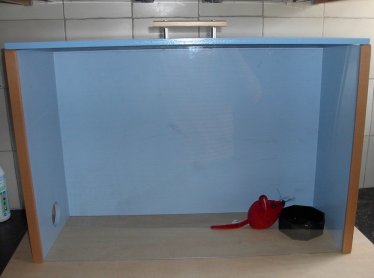
Very often cats want to eat the food that is not meant for them. If you give the kittens kitten food, especially the older cats will dig in enthusiastically. A feeding cage like this one has a small hole at the side, so only the small kittens can enter the cage and eat the food you place inside. This of course does not prevent the kittens from joining their parents and eating the adult food. Photo credit: Annemiek Frieswijk.


Often people use a cardboard box as a birthing box. This can be very handy, since you can throw it away after the delivery and you do not need to clean it afterwards. However, remember that boxes that contained fruit are often treated with pesticides! That's why the use of cardboard boxes is dissuaded. This birthing box was bought at IKEA. It is made of plastic and is very easy to clean. Photo credit: Riëtte van Beek.
You can also buy collapsible pet homes, they look like small tents. These too can be used as a birthing box, kitten cage etc. The advantage is that when you don't use them, you can fold them into small packages that are easy to store. The disadvantage is that these pet homes usually are expensive.
For the birthing box/kitten cage or wherever the kittens are lying, it is best if you use white fabric as lining. Most moms are very good cleaners, and they clean their babies immediately when they get dirty. This is of course a very good thing, but if a kitten has abnormal stools, it might take a while before you realize something is wrong. White sheets or pillowcases have the advantage that you can see the stains left behind from the stool and you can tell whether the color of it is normal.
For litter boxes you can also look for other solutions then the expensive options the pet store will offer you. Check out department stores if they have baby bathtubs or laundry baskets that you can use for litter boxes. Kittens do not need a very large litter box, they cannot climb in a large litter box anyway. Use a small tub for the kittens where at one side you cut out a hole so the kittens can get in and out, or maybe you can use a tray with a raised border.
Then of course in every cat household there should be a scratching post. Cats do not care if it is a beautiful post, they want to be able to sharpen their nails. You do not need to spend hundreds of euro's to have something that will make your cats happy. Creative do-it-yourself projects with wood, sisal rope and leftover pieces of carpet will do just nicely. Just make sure there are no nails or staples sticking out.
General Care
When one thinks of taking care of cats, most people think of the most obvious, namely supplying food, water and - if necessary- medical help. The best food you can give your cats is a premium brand, and not the supermarket brands. Of course the cats eat the supermarket food when it is offered to them, but it is not the best you can give them.
Less obvious are the grooming aspects. Sometimes the cat needs to have its nails clipped, its coat brushed, or even washed. This is not always necessary, but if you attend a show the judges will appreciate it a lot when there has been made an effort to make the cat look good. If you own a longhaired cat you will also have to brush it to prevent the animal from being covered in mats. Whether the cat needs a bath or just a bit of brushing depends on the breed (shorthair, semi-longhair or longhair) and on the cat itself (one cat has a dry coat, while the other has a greasy coat). There is a lot of information on the Internet about how to bath your cat and which products you can use for that. But you can also ask some experienced breeders who work with your breed for advice; they know how to groom their breed and how to present their cats the best way possible.
Dangers of breeding
Breeding animals is not always easy, many breeders can tell you their bad experiences. Almost every experienced breeder has been in a difficult situation once or twice. Kittens can die, females can become seriously ill or they might even die at a young age. Luckily, this does not happen often, but please bear in mind that every pregnancy is a risk for both the female and her kittens.
Dangers to the mother
Like mentioned above sometimes fatal complications occur during the pregnancy or delivery. The mother can get problems when one of the kittens is too big and it gets stuck in the birth canal. It can also happen that one of the uterus horns gets twisted (called uterine torsion), so that the kittens cannot be delivered, and the mother as well as the kittens will die if the problem is not recognized quickly enough by the vet. Eclampsia can develop before or after the delivery which increases the risk of the mother and/or the kittens to not survive this. Luckily in most cases everything goes all right, and these examples mentioned above are the exceptions.
Dangers to the kittens
The kittens can of course get ill too. This can vary from an occasional dirty eye to a bacterial infection with severe consequences. Next to that, kittens can get into problems while they are exploring the world. It would not be the first time a kitten bites through an electric wire and gets an electric shock. A small hole or chink behind furniture is also very interesting to a young kitten. It happens regularly that kittens crawl into these small spaces where they cannot escape from without help. Clumping litter can also be a danger to kittens. Kittens are just as curious as human babies, they put everything in their mouths and they want to taste everything. Clumping litter causes internal blockage with terrible consequences. Therefore it is better to use wood pellets or non-clumping litter as litter box filling for kittens.
Determining Gender In Kittens
It is very handy to be able to determine the gender of your kittens. You would not be the first breeder who named a male "Lady", or a female "Tarzan"... In the pictures below you can see the differences between the males and females. As you can see the distance between the genital openings is smaller for a female as it is for a male. You can also see that the female has a bald stripe in between the genital openings, where the male has a hairy piece. Note: the presence of nipples does not say anything about the gender of a kitten!
| A female (top) and a male (bottom) at the age of 10 days. At this age it is very obvious that the female has a bald stripe inbetween the genital openings (red circled), while the male has a hairy piece at that spot. Also the distance between the genital openings is smaller for the female as it is for the male (red arrow). | |
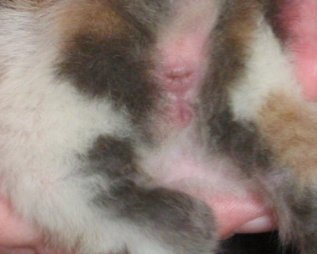 |
 |
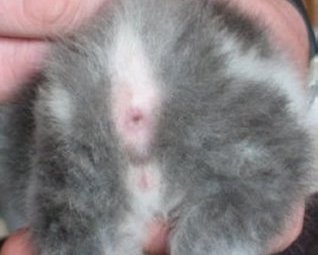 |
 |
| Photo credit: Misha Peersmans. | |
Here the kittens are 5 weeks old. At this age the female (top) also has some hair between her genital openings. However, the male (bottom) has much more hair. Next to that the difference in distance between the openings has become larger. |
|
 |
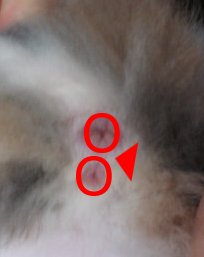 |
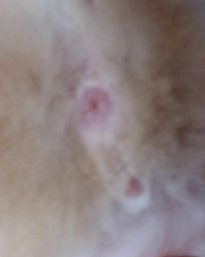 |
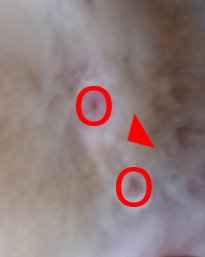 |
| Photo credit: Misha Peersmans. | |
Socialization
Socializing kittens means that they have to get adjusted to everything they can encounter later on in their life. This does not mean that a well socialized kitten will never be afraid of anything, or that it will never be startled by anything. Or that all kittens coming from one breeder will react exactly the same in similar situations. Every kitten is an individual and reacts in its own way. What you can teach kittens is not to be scared of loud noises, like the vacuum cleaner, the doorbell, the radio or television, or when people raise their voices. You can also teach them different forms of handling you will perform on the kittens later on. Picking them up, holding them, laying them down on their back, clipping the nails, checking the teeth, brushing, washing, in short: everything you do with adult cats can be taught to them during this period. This does not need to last for hours per day, 10 minutes or so is enough. But of course you may always spend more time with the kittens......
Administration
Keeping an administration is a boring chore, but it can be a very useful tool when you work with cats. As a pet owner it will be sufficient most of the time if you simply write remarks down in your diary. Should you have to go to a vet because your cat is limping, then it is convenient for you to know whether the animal is limping because it has fallen of off a cupboard or if something else has happened. Afterwards it often is difficult to remember exactly when something has happened.
For a professional cattery it is gets more complicated, especially when there are more breeding animals in the house. Questions like: "When was female X in heat the last time?", "When was the litter of female Y born?" and "Which of the 4 brown tabby kittens dropped in weight? Is it the same kitten that had problems eating last week?" can be hard to answer if you have to start digging in your memory. Most of the times you can retrieve this information, but with a well-maintained administration the information is much more reliable. Plus, such an administration comes in very handy if you might get sick yourself, and friends or family have to step in to take care of your animals. With one glance they can tell what is going on in your cattery.
The tables below are examples. Of course you can adjust them to your own wishes and situations.
Birth table
In the table below I made space to fill in who the parents of the litter are, what the mating dates were, and all kind of other information about every kitten like the time of birth, which code you have given the kittens (when they have strong resemblances it might be a good idea to mark each kitten with nail-polish on their nails or with a safe text-marker in their coat) etc. If you want to add other, more important things you can simply add them or replace the columns I that used.
| Name Male: | |||||||
| Name Female: | |||||||
| First and last mating date | Birthdate | Number of days after the first mating (=gestation) | Date on which the kittens can go to their new owners. | ||||
| Kitten nr | Male/Female | Name | Weight | Time of birth | Color and Pattern | Marker Code / (Nailpolish?) | |
| 1. | |||||||
| 2. | |||||||
| 3. | |||||||
| 4. | |||||||
| 5. | |||||||
| 6. | |||||||
| 7. | |||||||
| 8. | |||||||
| 9. | |||||||
Kittenweight table
It is best to pick a set time on which you weigh the kittens every day, so not during the evening the first day, and in the morning the next day. This would give you a wrong picture.
If one or more of the kittens do not gain weight on one day, this is not a disaster immediately. Only if they do not gain weight for a few days in a row, or when they loose weight, there is reason to start worrying.
| Kittens: | |||||||
| Date | 1 | 2 | 3 | 4 | 5 | 6 | 7 |
Recommended Literature
- Robinson's Genetics for Cat Breeders and Veterinarians by Carolyn M. Vella, Lorraine Shelton, John McGonagle, Terry W. Stanglein.
- The Cornell Book of Cats by Mordecai Siegal, James R. Richards, Cornell Feline Health Center.
- Cat Owner's Home Veterinary Handbook by Delbert G. Carlson, James M. Giffin.
- Breeding Purebred Cats by Anne S. Moore.
- The Book of The Cat by Michael Wright, Sally Walters.
